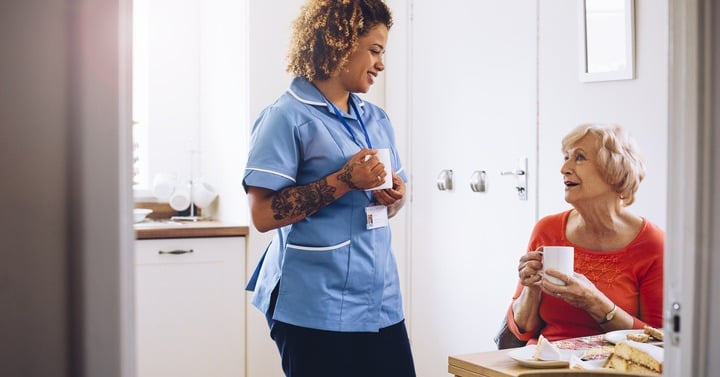How Innovation Can Solve The Challenges Care Homes Face
5 minute read | 29/09/2020

There are an estimated 5,153 nursing homes and 12,525 residential homes in the UK today, providing accommodation to more than 426,000 people. A significant proportion of the UK’s elderly population are residents in these homes.
Lack of awareness, short-term disruption, confidentiality concerns and reliance on technology are just some of the challenges the industry is facing. Can innovation address the challenges care homes face for our ageing population?
- Easier Monitoring of Residents
- Better, Safer Data Sharing
- Solve Communication Downfalls
- Pivot During a Pandemic
- Tech Can Tame Resident Isolation
Easier Monitoring of Residents
An increasing number of older people, with complex health and social care needs, are living in residential care homes. Even though healthcare professionals are doing a fantastic job on the frontline, it’s impossible for them to be everywhere at once. Technology can help fill in gaps and improve the quality of care.
With care homes trying to do everything they can to shield their residents from COVID-19, including keeping carers on-site, reducing contacts and avoiding external visitors from coming in that might put the residents at risk, remote monitoring is pivotal.
Digital technology allows care home residents to be appropriately assessed on a regular basis. Assessments are done by carers or nurses taking patients’ vital signs readings and answering straightforward questions that are clinically validated, supported by sophisticated algorithms to give answers swiftly.
With care homes vulnerable to the virus, remote monitoring can uncover suspected cases earlier to prevent outbreaks and protect the lives of those most susceptible.
Better, Safer Data Sharing
Reports commissioned by Advanced Health and Care Partner Division showed that almost 80% of care organisations still use paper records. Investing in technology that can replace the amounts of paperwork carers often have to deal with allows for more time to be spent with residents.
Supported by tech, staff can share digital records more easily and accurately. Investing in accessible handheld devices, staff can keep a record of support given as it happens. This avoids having to complete long-winded paper records that make communicating these simple events difficult.
You can even utilise the existing hardware you already have available, such as tablets, phones and laptops. With electronic data, it’s also easier to securely share data between the care home and a hospital, so records can be kept up-to-date and a resident’s doctor can be notified of their patients’ health changes and take action.
Solve Communication Downfalls
When it comes to communicating with residents, technology digitally enables those who would otherwise be excluded. This way they can be involved with their care plan and get the support they need.
Despite these positive attributes to the uptake of technology, consideration must always be made concerning any technologies used to benefit residents.
For hard of hearing residents or those with poor vision, speech recognition technology can be used to understand their requests and what they require to feel comfortable. It’s a small addition that makes the world of difference to residents and staff alike.
Pivot During a Pandemic
While care home providers continue to face a number of challenges during the COVID-19 crisis, many are still striving to innovate in order to support their staff and provide the best care for their clients.
COVID-19 has been the catalyst for digital transformation at pace. Here’s a list of just five innovative ways care homes are overcoming these hurdles:
- Seven NHS Trusts are using technology developed by SPARK TSL in response to an urgent request from leading NHS Trusts to find a way to connect residents with their loved ones during the coronavirus outbreak with 600 tablets. These include video calling via Visionable:Connect, a secure video calling platform that residents, their families and friends can use without having to register or set up an account.
- A home care provider based in Swindon has invested in 3D printers to engineer its own personal protective equipment (PPE). With increasing concerns over the supply and availability of PPE, directors at First City Nursing and Care decided to take matters into their own hands in order to protect its staff and 600 elderly and vulnerable clients.
- Rusthall Lodge is live-streaming exercise for residents.
- Within days of national advice to stop all but essential face to face services the Physio and MSK services adopted a virtual service model. All consultations were immediately changed to telephone consultations.
- St Richard’s Hospice is supporting nursing in care homes. They provide online teaching about COVID-19 management and end of life palliative care.
Although care home doors are closed to outsiders, community engagement is still possible and remains hugely important. There is pressure from CQC to push care homes towards improvement – this means that those with sufficient resources have a strong incentive to improve their status.
Tech Can Tame Resident Isolation
One major challenge in care homes, especially with lockdown restrictions, is residents becoming disconnected from the wider world. If not particularly mobile, residents may be reliant on family visits for contact to combat isolation.
Introducing care homes to technology such as video calling on a user-friendly platform can help care home residents communicate on a more interactive level with friends and family.
This helps them maintain a sense of connection to the outside. On a more basic level, introducing residents to an entertainment platform is a great way to help them remain engaged with life. When we empower those in care, it makes for a more positive experience for everyone. Especially during these current challenges we face.
Residents’ safety, dignity and consent must be at the centre of decisions about their care. This becomes imperative when there are decisions about innovation in care homes. With everything available at the touch of a button, tech solutions can help staff spend more time on the things that really matter - the residents. What solution can benefit them?
Find the Right Innovative Care Solution for You
If you’re interested in finding out how patient entertainment systems have evolved and what modern platforms can do for care homes and your residents - then click to start our quiz below.
It can be difficult to know what will alleviate the challenges you face, but it takes into consideration the CQC checklist, budget and requirements and matches you with a solution that can revolutionise your care. Click the button below to start.
About the author
Rebecca O'Donovan
Becky is the Marketing Director at SPARK TSL, of whom she has worked for since 2012. She is responsible for high-level marketing strategy focusing on lead generation and aiding the vision of the business to ensure business growth.
More articles by the author
Related articles
 Healthcare Industry
Healthcare Industry
4 Ways Technology in Care Homes Can Improve Quality Of Care
Technology is changing the way we provide care and treatment. It’s an ever-increasing presence in our daily ...
 Patient Experience
Patient Experience
How Important Is Family Engagement in Patient Care?
Families play a vital role in the health and well-being of individuals, particularly in healthcare. Research ...
.png?width=386&height=180&name=Blog%20feature%20image%20(2).png) Patient Experience
Patient Experience
How SPARK TSL Helps Hospital Charities Raise Awareness and Support
Welcome to the third instalment of Matchmaking March, our blog series where we pair NHS challenges with the ...


